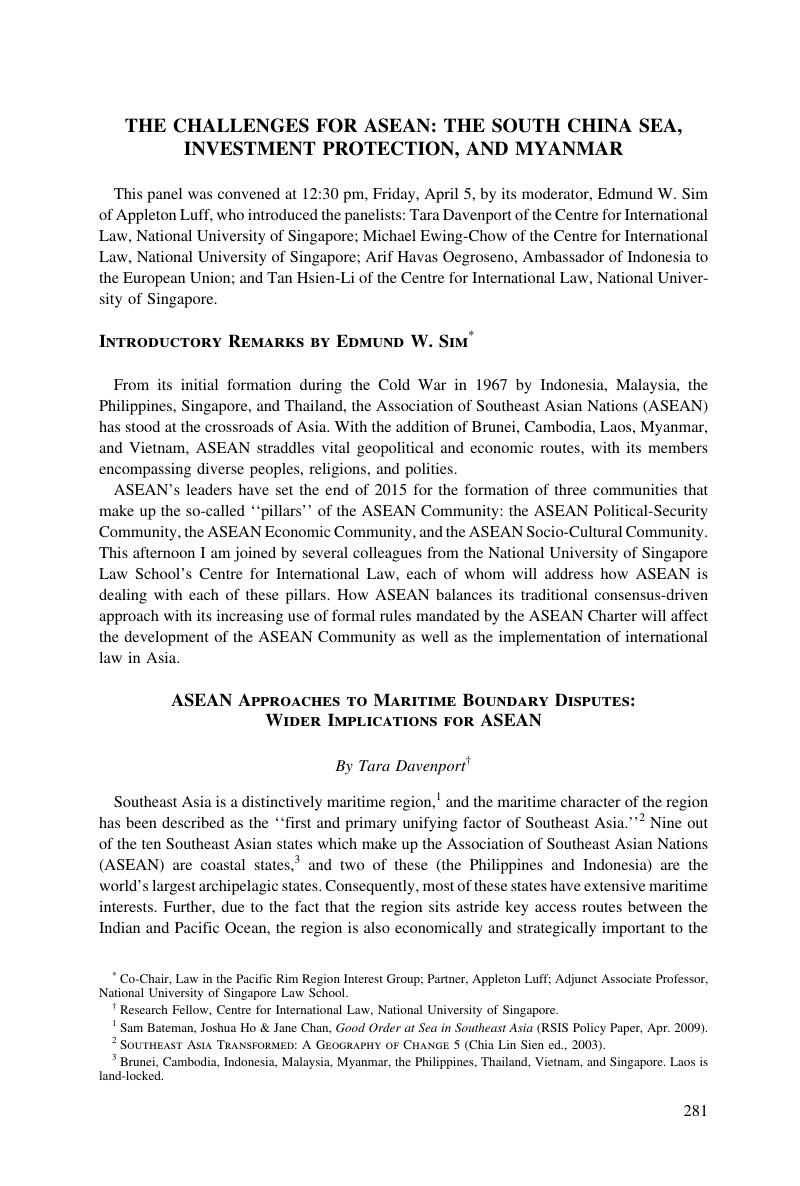No CrossRef data available.
Published online by Cambridge University Press: 20 January 2017

1 Bateman, Sam, Ho, Joshua & Chan, Jane, Good Order at Sea in Southeast Asia (RSIS Policy Paper, Apr. 2009).Google Scholar
2 SOUTHEAST Asia Transformed: A Geography of Change 5 (Chia Lin Sien ed., 2003).
3 Brunei, Cambodia, Indonesia, Malaysia, Myanmar, the Philippines, Thailand, Vietnam, and Singapore. Laos is land-locked.
4 Bateman, Ho & Chan, supra note 1, at 11. There are numerous straits used for international navigation in the region including the Straits of Malacca and Singapore, the Lombok/Makassar Straits/Sunda Straits/Philippines Straits. There are also major ports such as Singapore, Port Klang, and Tanjung Pelapas in Malaysia, and Tanjong Priok in Indonesia.
5 United Nations Convention on the Law of the Sea (UNCLOS), Dec. 10, 1982, 1833 U.N.T.S. 397, 21 I.L.M. 1261 (entered into force Nov. 16, 1994). Cambodia signed UNCLOS on July 1, 1983, but has not ratified it. Brunei ratified UNCLOS on November 5, 1996; Indonesia on February 3, 1986; Laos on June 5, 1998; Malaysia on October 14, 1996; Myanmar on May 21, 1996; the Philippines on May 8, 1984; Singapore on November 17, 1994; Thailand on May 15, 2011; and Vietnam on July 25, 1994.
6 Bateman, Chan & Ho, supra note 1, at 8.
7 Douglas M. Johnston & Mark Valencia, Pacific Ocean Boundary Problems: Status and Solutions 50 (1991).
8 Victor Prescott & Clive Schofield, The Maritime Political Boundaries of the World 429 (2d ed. 2005).
9 Johnston & Valencia, supra note 7, at 66; McDorman, Ted L., Central Pacific and East Asian Maritime Boundaries, in 5 International Maritime Boundaries, 3442 (Charney, Jonathan & Alexander, Lewis eds., 2005)Google Scholar.
10 Pursuant to UNCLOS, supra note 5, arts. 15, 74(1), 83(1).
11 Id. arts. 74(3), 83(3).
12 Although not all of these agreements are currently in effect.
13 See ITLOS website at http://www.itlos.org/index.php?id=108&L=l%2F. However, it should be noted that while this is the only maritime boundary dispute submitted to binding dispute settlement mechanisms, both Indonesia and Malaysia as well as Singapore and Malaysia have submitted their respective sovereignty disputes over Sipadan and Ligitan, as well as over Pedra Branca, to the ICJ. Malaysia has also initiated arbitration proceedings against Singapore and requested for provisional measures from ITLOS to curtail Singapore’s land reclamation activities.
14 Triggs, Gillian, Confucius and Consensus: International Law in the Asian Pacific, 21 Melb. U. L. Rev. 650, 675 (1997)Google Scholar.
15 Walter Woon, Dispute Settlement in ASEAN (Oct. 17, 2011), at http://cil.nus.edu.sg/wp/wp-content/uploads/2010/08/DISPUTE-SETTLEMENT-IN-ASEAN-KSIL-ProfWalterWoon.pdf.
16 Goh, Gillian, The ASEAN Way: Non-intervention and ASEAN’s Role in Conflict Management, 3 Stan. J. East Asian Aff. 113, 114 (2003)Google Scholar.
17 Triggs, supra note 14, at 675.
18 Sarin, Manohar, The Asian-African States and the Development of International Law, in Third World Attitudes Toward International Law (Snyder, Frederick & Sathirathai, Surakiart eds., 1987)Google Scholar.
19 Triggs, supra note 14, at 659.